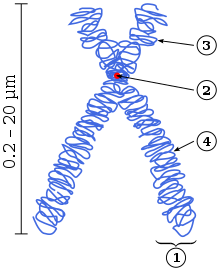
Back Geenlokus Afrikaans موقع صبغوي Arabic Lokus Azerbaijani Локус Bashkir Локус (генетика) Bulgarian Lokus (gen) BS Locus Catalan Lokus (genetika) Czech Locus (genetik) Danish Genlocus German

(1) Chromatid
(2) Centromere
(3) Short (p) arm
(4) Long (q) arm
In genetics, a locus (pl.: loci) is a specific, fixed position on a chromosome where a particular gene or genetic marker is located.[1] Each chromosome carries many genes, with each gene occupying a different position or locus; in humans, the total number of protein-coding genes in a complete haploid set of 23 chromosomes is estimated at 19,000–20,000.[2]
Genes may possess multiple variants known as alleles, and an allele may also be said to reside at a particular locus. Diploid and polyploid cells whose chromosomes have the same allele at a given locus are called homozygous with respect to that locus, while those that have different alleles at a given locus are called heterozygous.[3] The ordered list of loci known for a particular genome is called a gene map. Gene mapping is the process of determining the specific locus or loci responsible for producing a particular phenotype or biological trait. Association mapping, also known as "linkage disequilibrium mapping", is a method of mapping quantitative trait loci (QTLs) that takes advantage of historic linkage disequilibrium to link phenotypes (observable characteristics) to genotypes (the genetic constitution of organisms), uncovering genetic associations.
- ^ Wood, E.J. (1995). "The encyclopedia of molecular biology". Biochemical Education. 23 (2): 1165. doi:10.1016/0307-4412(95)90659-2.
- ^ Ezkurdia, Iakes; Juan, David; Rodriguez, Jose Manuel; Frankish, Adam; Diekhans, Mark; Harrow, Jennifer; Vazquez, Jesus; Valencia, Alfonso; Tress, Michael L. (2014-11-15). "Multiple evidence strands suggest that there may be as few as 19,000 human protein-coding genes". Human Molecular Genetics. 23 (22): 5866–5878. doi:10.1093/hmg/ddu309. ISSN 1460-2083. PMC 4204768. PMID 24939910.
- ^ "NCI Dictionary of Genetics". National Cancer Institute. Archived from the original on 26 April 2015. Retrieved 13 December 2014.